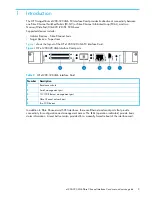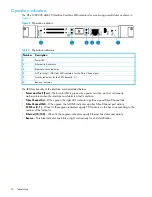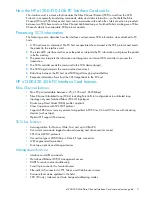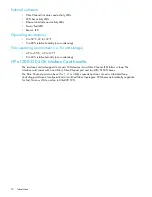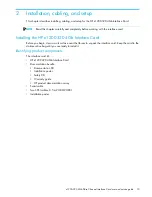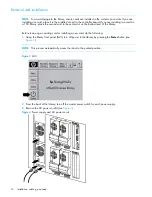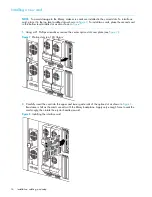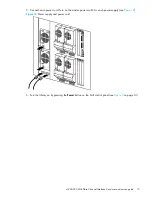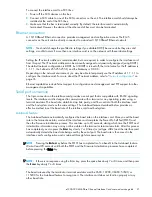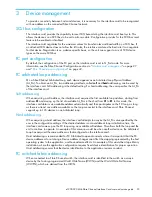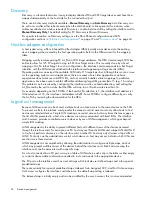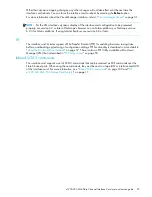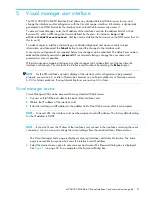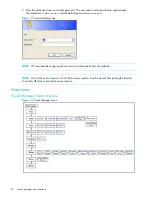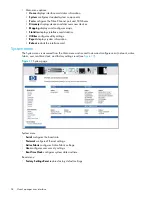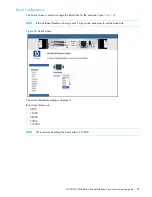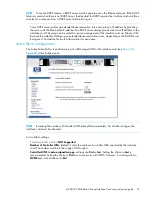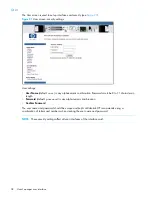
e1200-320 4Gb Fibre Channel Interface Card user and service guide
23
3
Device management
To provide connectivity between hosts and devices, it is necessary for the interface card to be recognized
with an address on the connected Fibre Channel network.
SCSI bus configuration
The interface card provides the capability to reset SCSI buses during the interface card boot cycle. This
allows the devices on a SCSI bus to be set to a known state. Configuration provides for the SCSI bus reset
feature to be enabled or disabled.
The interface card negotiates for the maximum values for transfer rates and bandwidth on a SCSI bus. If
an attached SCSI device does not allow the full rates, the interface card uses the best rate it can negotiate
for that device. Negotiation is on a device specific basis, so the unit can support a mix of SCSI device
types on the same SCSI bus.
FC port configuration
By default, the configuration of the FC port on the interface card is set to N_Port mode. For more
information, see the Fibre Channel Configuration sections in ”
Interface card management
” on page 27
and ”
Fibre Channel port configuration
” on page 42.
FC arbitrated loop addressing
On a Fibre Channel Arbitrated Loop, each device appears as an Arbitrated Loop Physical Address
(AL_PA). To obtain an AL_PA, two addressing methods, called
soft
and
hard
addressing, can be used by
the interface card. Soft addressing is the default setting. For hard addressing, the user specifies the AL_PA
of the interface card.
Soft addressing
When acquiring a soft address, the interface card acquires the first available loop address, starting from
address
01
and moving up the list of available AL_PAs in the chart from
01
to
EF
. In this mode, the
interface card obtains an available address automatically and then participates on the FC loop, as long
as there is at least one address available on the loop connected to the interface card. Fibre Channel
supports up to 126 devices on an Arbitrated Loop.
Hard addressing
When acquiring a hard address, the interface card attempts to acquire the AL_PA value specified by the
user in the configuration settings. If the desired address is not available at loop initialization time, the
interface card comes up on the FC loop using an available soft address. This allows both the loop and the
unit to continue to operate. An example of this scenario would be when another device on the Arbitrated
Loop has acquired the same address as that configured on the interface card.
Hard addressing is recommended for FC Arbitrated Loop environments where it is important that the FC
device addresses do not change. Device address changes can affect the mapping represented by the host
operating system to the application, and have adverse effects. An example of this would be a tape library
installation, where the application configuration requires fixed device identification for proper operation.
Hard addressing ensures that the device identification to the application remains constant.
FC switched fabric addressing
When connected to a Fibre Channel switch, the interface card is identified to the switch as a unique
device by the factory programmed World Wide Name (WWN) and the World Wide Port Names
(WWPN), which are derived from the WWN.
Содержание StorageWorks e1200-320
Страница 26: ...26 Device management ...
Страница 30: ...30 Interface card management ...
Страница 92: ...92 Using the FTP interface ...
Страница 98: ...98 Troubleshooting ...
Страница 102: ...102 Serial and Ethernet pin assignments ...
Страница 108: ...108 Regulatory compliance and safety ...
Страница 122: ...122 Enabling DHCP on the HP e1200 320 4Gb FC Interface Card ...

